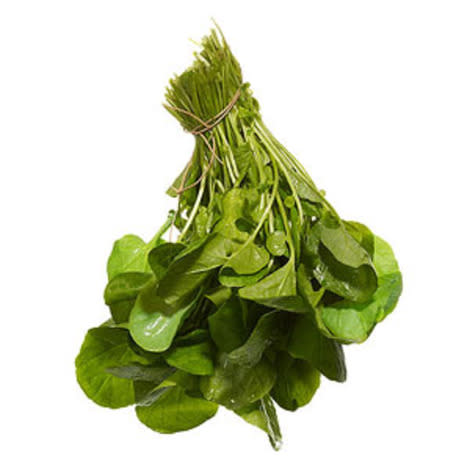Get to Know Your Greens: 5 Veggies to Add to Your Plate
By Sharon Liao
If you think escarole refers to Jay-Z's SUV, it's time for a veg-ucation. Get to know seven produce powerhouses that deserve a spot in your crisper.
Related: 10 Vegetarian Meals to Make for Meatless Monday
Collard Greens
This mild staple of Southern cuisine may be better at lowering artery-clogging cholesterol than broccoli or spinach, research has shown.
Fresh ideas: Try a lighter take on collards, which are traditionally cooked with pork fat: Remove the stems and slice the leaves into two-inch pieces; meanwhile, fry turkey bacon in olive oil. Crumble bacon and sauté it with the collards and garlic. Add enough chicken stock to just cover the greens, reduce the heat to low, and simmer for an hour, or until tender. "Cooking collards for a long time breaks down the tough fibers," says Aliza Green, a chef in Philadelphia and the author of Field Guide to Produce. Finish the dish with a splash of apple cider vinegar and red pepper flakes.
Collards resemble wide, flat cabbage leaves. Look for a deep green hue.
Kale
Curly kale, shown here is deep green with ruffled edges. Tuscan kale, aka dinosaur or black kale, has bumpy blue-green leaves.
This earthy, bitter green is sweeter in winter, but it's packed with nutrients year-round. Just one cup of raw kale supplies a day's worth of vitamins A and C and six times the daily requirement of bone-boosting vitamin K.
Fresh ideas: Make chips by stripping the leaves off the tough, inedible stems and tearing them into one-and-a-half-inch pieces. Toss with olive oil and salt and bake at 350 degrees for 10 to 15 minutes, or until crispy. For a simple no-cook side dish, slice kale into one-inch ribbons, add a tablespoon each of olive oil and lemon juice and a dash of salt; then gently massage with your fingertips until the leaves are wilted. Top with freshly ground black pepper, nuts or seeds for crunch, and either avocado slices or a sprinkle of pecorino.
Turnips
Avoid leaves that are wilted or yellow or have slick dark green patches.
When you cook turnips, don't throw out the tops, which have a strong flavor and cabbagelike texture. "They're loaded with fiber and vitamin K," says Maggie Moon, RD, a nutritionist for the New York City-based online grocer FreshDirect. One cup of the cooked greens fulfills 20 percent of the daily requirement for vitamin B6.
Fresh ideas: "Blanch turnip greens to soften their bite," Green says. "Then sauté them in olive oil with garlic and finish with a little lemon juice or apple cider vinegar." Or sauté garlic, onion, and lemon zest in olive oil; add turnip greens and white wine and simmer until soft. Then puree in a blender and serve as a dip with crusty bread.
Related: 20 Fresh, Easy Veggie Side Dishes
Bok Choy
Choose thick, firm stalks and bright leaves. Bok choy is also called Chinese cabbage or pak choi.
This mild, slightly sweet cousin of cabbage is a super source of calcium because it's low in oxalate, a compound in many greens that blocks absorption of the mineral. The veggie also has 25 kinds of cancer-fighting antioxidants called polyphenols, one study found.
Fresh ideas: Small, tender baby bok choy is great in stir-fries or tossed with oil, salt, and black pepper and roasted at 400 degrees for five minutes. If you're cooking the regular-size kind, make a side dish by chopping the stalks and sautéing them in oil with garlic, ginger, and reduced-sodium soy sauce for three to four minutes. "Then add the greens a few minutes before serving, so that the stalks are tender and the leaves are just wilted," Moon suggests.
Related: Get the Full Shopping List: More Greens to Stock Up On

Watercress
The small, oval-shaped leaves should smell peppery.
Watercress packs a healthy punch of vision-protecting carotenoids and compounds that may inhibit the growth of breast cancer tumors.
Fresh ideas: Trim the stems, then add the leaves to sandwiches, frittatas, and salads. "Pair watercress with a sweet balsamic vinaigrette," says Andrea Giancoli, RD, a spokesperson for the Academy of Nutrition and Dietetics. Or transform a simple supper into dinner party fare by using fresh leaves as a bed for roast chicken or beef. To make soup, sauté a cubed potato and a diced onion, then simmer them in two cups each of low-fat milk and chicken stock for 10 minutes, or until tender. Add two cups of watercress (leaves and stems), cook five minutes more, and puree until smooth. Garnish with fresh watercress leaves and low-fat sour cream.
More from FITNESS Magazine:
10 Exercises to Love Your Legs
How Competitive Are You? Women Spill Their Success Secrets
10 Tips to Lose the Weight and Keep It Off for Good
